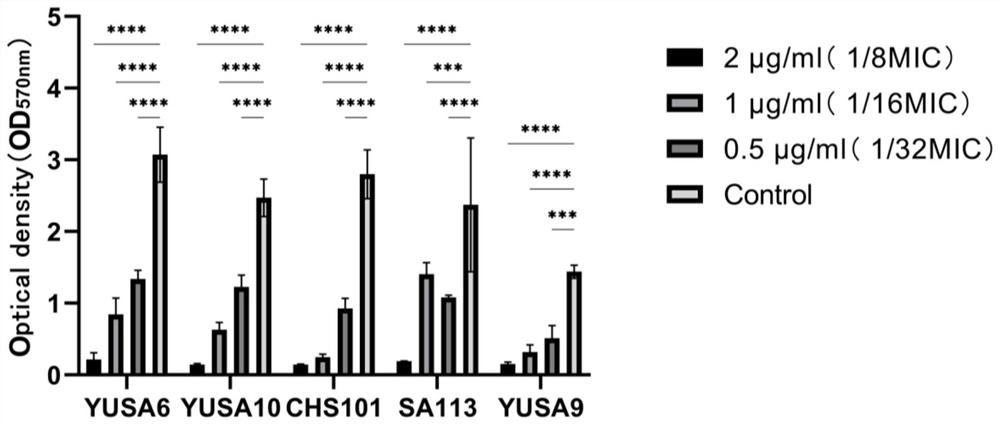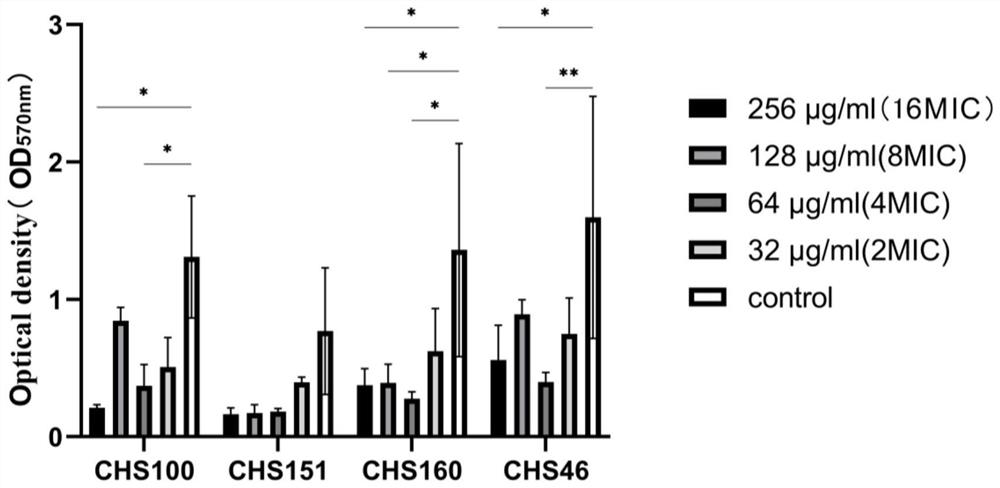Application of benzbromarone in resisting infection of staphylococcus aureus and biofilm thereof
A technology of benzbromarone and staphylococcus, applied in the field of medicine, can solve problems such as prolonged infection duration, unsatisfactory biofilm effect, and failure of infection treatment
- Summary
- Abstract
- Description
- Claims
- Application Information
AI Technical Summary
Problems solved by technology
Method used
Image
Examples
Embodiment 1
[0035] Minimum inhibitory concentration (Minimum inhibitory concentration, MIC) detection:
[0036]The minimum inhibitory concentration (MIC) was carried out by the micro broth dilution method, with ATCC29213 as the quality control strain, and the operation was carried out according to the CLSI-M100-S27 version. At the same time, vancomycin, linezolid, ampicillin and benzbromarone are used as comparative examples, and the results are shown in Table 1 below. MSSA and methicillin-resistant strain MRSA) have antibacterial and bactericidal effects, and their MIC is 16mg / L.
[0037] Table 1 The minimum inhibitory concentration of benzbromarone to Staphylococcus aureus
[0038]
Embodiment 2
[0040] The present embodiment is the experiment that the benzbromarone of detection sub-inhibitory concentration inhibits Staphylococcus aureus from forming biofilm, and specific method comprises:
[0041] Staphylococcus aureus methicillin-sensitive strains (MSSA) CHS100, CHS151, CHS160 and CHS46 and methicillin-resistant strains (MRSA) CHS823, CHS733, CHS736 and CHS727 strains were shaken in TSB medium at 37°C and 220rpm / min Cultivate overnight for 10-12h. Use TSBG medium (TSB medium + 0.5% glucose) to dilute the bacterial solution 1:200 (with or without therapeutic bacteria drugs), add 200ul per well to a 96-well plate (Costar3599), set 3 duplicate wells for each strain, and 37 Cultivate statically for 24 hours. Discard the supernatant, wash with PBS 3 times (200ul / well / time), dry at room temperature, add methanol for fixation for 15min (200ul / well), discard methanol and add 100ul of 0.5% crystal violet staining solution to each well after drying at room temperature. Stain...
Embodiment 3
[0044] This example verifies the experiment that benzbromarone effectively removes the biofilm formed by Staphylococcus aureus.
[0045] Staphylococcus aureus methicillin-sensitive strains (MSSA) CHS100, CHS151, CHS160 and CHS46 and methicillin-resistant strains (MRSA) CHS823, CHS733, CHS736 and CHS727 were shaken in TSB medium at 37°C and 220rpm / min overnight Cultivate for 10-12h. Dilute the bacterial solution 1:200 with TSBG medium (TSB medium + 0.5% glucose), add 200ul per well to a 96-well plate (Costar 3599), set 3 duplicate wells for each strain, and culture at 37°C for 24 hours to form a mature biofilm. Discard the supernatant, wash with sterile normal saline for 3 times (200ul / well / time), then add fresh TSBG medium (containing different concentrations of benzbromarone), and culture for 48h (replace with a new one every 24h). After that, discard the supernatant, wash with PBS 3 times (200ul / well / time), dry at room temperature, add methanol for fixation for 15min (200u...
PUM
| Property | Measurement | Unit |
|---|---|---|
| Concentration | aaaaa | aaaaa |
| Concentration | aaaaa | aaaaa |
| Concentration | aaaaa | aaaaa |
Abstract
Description
Claims
Application Information
 Login to View More
Login to View More - R&D
- Intellectual Property
- Life Sciences
- Materials
- Tech Scout
- Unparalleled Data Quality
- Higher Quality Content
- 60% Fewer Hallucinations
Browse by: Latest US Patents, China's latest patents, Technical Efficacy Thesaurus, Application Domain, Technology Topic, Popular Technical Reports.
© 2025 PatSnap. All rights reserved.Legal|Privacy policy|Modern Slavery Act Transparency Statement|Sitemap|About US| Contact US: help@patsnap.com



